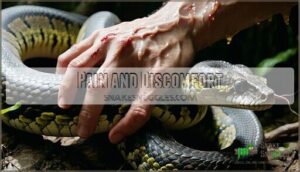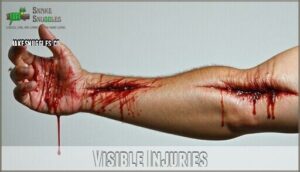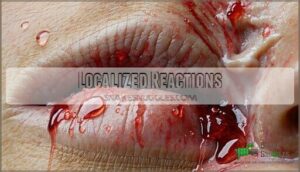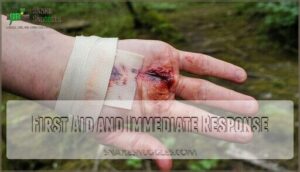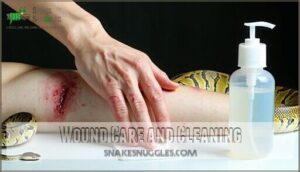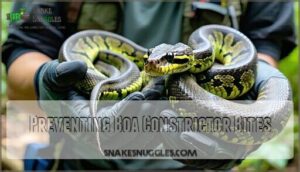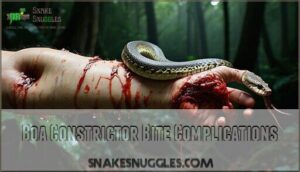This site is supported by our readers. We may earn a commission, at no cost to you, if you purchase through links.
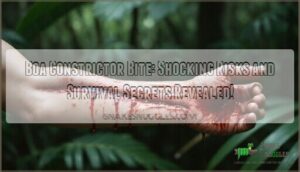
While these snakes aren’t naturally aggressive, they’ll chomp down if they feel threatened or mistake you for prey.
You’ll likely experience painful puncture wounds with potential bleeding and swelling.
Don’t panic, but act fast: clean the wound thoroughly, control bleeding, and watch for signs of infection.
Unlike venomous snake bites, boa constrictor bites primarily risk bacterial contamination.
Seek medical attention, especially if you notice increasing pain, redness, or unusual discharge.
Professional treatment might include wound cleaning, potential antibiotics, and tetanus prevention.
Remember, prevention beats cure – understanding snake behavior and maintaining safe handling practices can keep you miles away from a boa’s bite.
Table Of Contents
- Key Takeaways
- Boa Constrictor Bite Risks
- Boa Constrictor Bite Symptoms
- Treating Boa Constrictor Bites
- Preventing Boa Constrictor Bites
- Boa Constrictor Bite Complications
- Frequently Asked Questions (FAQs)
- How bad is a boa constrictor bite?
- How to treat a boa constrictor bite?
- What happens if a rosy boa bites you?
- Why did my boa constrictor bite me?
- What happens if a boa constrictor bites you?
- Can a boa constrictor hurt a human?
- How do you treat a boa snake bite?
- How aggressive are boa constrictors?
- Can boa constrictors transmit diseases through bites?
- How long does it take for a bite to heal?
- Conclusion
Key Takeaways
- You’ll need to act fast if bitten by a boa constrictor. Immediate first aid involves cleaning the wound thoroughly, controlling bleeding, and seeking medical attention to prevent potential bacterial infections.
- Unlike venomous snake bites, a boa constrictor’s bite primarily risks wound contamination. Your primary concerns will be preventing infection, managing pain, and monitoring for complications like swelling or unusual discharge.
- While boa constrictors aren’t naturally aggressive, they’ll bite when feeling threatened or mistaking you for prey. Understanding their body language and handling them carefully can dramatically reduce your chances of getting bitten.
- Professional medical treatment is crucial after a boa constrictor bite. You’ll likely need wound cleaning, potential antibiotics, and a tetanus prevention assessment to ensure proper healing and minimize long-term health risks.
Boa Constrictor Bite Risks
If you’re exploring the realm of boa constrictors, understanding their bite risks is vital for your safety.
While these non-venomous snakes aren’t typically aggressive, their powerful jaws and sharp teeth can deliver painful wounds that require immediate attention and careful treatment.
Causes of Boa Constrictor Bites
Ever wondered what triggers a boa constrictor’s bite?
Handling stress, sudden movements, or feeding time tension can transform a calm boa into a striking defensive predator.
Most boa constrictor bites stem from handling provocation, stressful environments, or habitat encroachment.
Defensive behavior peaks during feeding times or when the snake feels threatened, and improper snake handling, sudden movements, and cornering can escalate snake aggression.
Turning a calm reptile into a defensive predator ready to strike, this behavior highlights the importance of careful handling and environment consideration to avoid triggering a boa constrictor’s bite.
Factors Affecting Bite Severity
When snake size matters, a larger boa constrictor packs a more serious bite punch.
The snake’s tooth condition and bite location dramatically impact injury severity. Your health, age, and reaction play pivotal roles in how badly you’ll be wounded.
Understanding these factors can mean the difference between a minor nip and a potentially dangerous snake bite injury.
Proper handling can mitigate risks, as juvenile boas are defensive.
Potential Complications
A bite-related nightmare can escalate quickly when dealing with boa constrictor wounds.
Your body’s response to these encounters may trigger unexpected challenges beyond the initial injury.
Some potential complications include:
- Scar tissue formation disrupting normal tissue function
- Psychological trauma impacting long-term mental health
- Compartment syndrome causing potential muscle and nerve damage
Understanding these risks empowers you to take swift, strategic action to address the potential complications.
Infection and Sepsis
When a boa constrictor’s bite breaks skin, bacterial sources can quickly transform a minor wound into a dangerous systemic infection.
Wound severity determines sepsis development risk, with untreated injuries potentially triggering serious complications.
Antibiotic resistance makes snake bite infection management tricky. Prompt, thorough wound care and professional medical assessment are your best defense against potentially life-threatening bacterial infiltration.
Boa Constrictor Bite Symptoms
If you’re bitten by a boa constrictor, you’ll need to understand the immediate and potential symptoms that could affect your health.
From painful lacerations to localized swelling, recognizing these signs quickly can help you respond effectively and minimize complications.
Recognizing these symptoms quickly is crucial for effective response.
Pain and Discomfort
When a predator strikes, your body sounds the alarm with intense bite wound pain that can make you wince.
The boa constrictor’s nonvenomous strike triggers sharp, throbbing discomfort that ranges from piercing to dull aches.
The intensity of the pain can vary, depending on the snake’s size and location.
Psychological impact hits hard as swelling and pain sensations escalate, testing your mental fortitude during this constrictor injury experience.
Visible Injuries
Puncture wounds from a boa constrictor’s bite can leave dramatic physical evidence.
You’ll likely notice immediate laceration severity ranging from shallow scratches to deep, jagged wounds that bleed profusely.
Tissue damage varies depending on bite location, with facial and hand injuries potentially causing more significant scarring potential.
These nonvenomous snake encounters demand careful assessment of physical trauma.
Systemic Reactions
When those sharp teeth break skin, your body might sound the alarm with a symphony of systemic reactions.
You could experience dizziness, weakness, and fainting—telltale signs of a potential anaphylaxis risk.
Watch for blurred vision, fever, and excessive sweating.
Nausea, vomiting, and diarrhea might crash your system, signaling deeper snake bite complications that demand immediate medical attention.
Even non-venomous bites can cause infection or allergic reactions.
Localized Reactions
At the moment of impact, your body reacts instantly to a boa constrictor bite with localized trauma.
Immediate pain erupts around the wound, accompanied by rapid swelling and potential tissue damage.
Blood vessels rupture, causing visible bruising and bleeding.
Your initial assessment should focus on controlling hemorrhage and preventing infection, recognizing each bite presents unique wound characteristics requiring careful evaluation to prevent infection.
Treating Boa Constrictor Bites
If you’ve been bitten by a boa constrictor, don’t panic—swift and precise action can prevent serious complications.
Your immediate response should focus on thorough wound cleaning, controlling bleeding, and seeking professional medical evaluation to assess potential infection risks, which requires precise action.
First Aid and Immediate Response
If those painful bite symptoms left you shaken, here’s your lifeline. Stay calm and act fast: control bleeding by applying direct pressure with a clean cloth.
Remove any jewelry near the wound. Keep the bite area lower than your heart to slow venom spread.
For effective first aid, consider using a specialized compression bandage. Monitor your symptoms closely and prepare to seek immediate medical attention for snake bite treatment.
Wound Care and Cleaning
Tackle a boa constrictor bite wound with precision and calm. Your first line of defense involves thorough wound care.
- Neutralize immediate infection risks
- Stop bleeding thoroughly
- Clean with antiseptic solutions
- Assess wound depth carefully
- Protect against potential contamination.
Immediate disinfection is vital. Gently clean the wound using sterile saline or mild antiseptic, controlling bleeding while minimizing scar potential through careful, methodical treatment.
You can also purchase a suitable antiseptic for wound care, which is a crucial step in promoting healing and preventing further complications.
Medical Treatment and Intervention
After cleaning the wound, you’ll need professional medical intervention to assess potential complications.
Surgical repair might be necessary depending on the bite’s location and severity.
Your doctor will evaluate nerve damage, perform imaging tests, and determine the best treatment approach.
Quick, thorough medical management can prevent long-term consequences and minimize infection risks from a boa constrictor bite.
Antibiotic Therapy
After addressing wound care, your medical defense shifts to bacterial infection prevention.
Prophylactic antibiotics become your shield against potential snake bite complications.
Broad-spectrum treatments like vancomycin and ceftazidime target multiple bacterial threats.
Treatment duration typically spans 72 hours, balancing infection prevention with antibiotic resistance concerns.
Your doctor will customize the specific antibiotics based on bite severity and individual risk factors.
Preventing Boa Constrictor Bites
When dealing with boa constrictors, understanding their behavior is your first line of defense against potential bites.
By learning safe handling techniques and recognizing warning signs, you’ll dramatically reduce your risk of experiencing a painful snake encounter.
Safe Handling Practices
After treating a boa constrictor bite, mastering safe handling practices becomes your shield.
Experienced keepers know proper enclosures and routine interaction reduce stress dramatically. Always use specialized handling equipment, move slowly, and respect the snake’s space.
For safer interactions, consider investing in specialized boa tools. Learn its body language, stay calm, and remember: confidence trumps fear when preventing snake bite risks.
Habitat and Environment
After mastering safe handling techniques, understanding the boa constrictor’s habitat becomes your next line of defense.
These serpents thrive in Central and South America’s tropical rainforests, adapting to diverse ecosystems from dense vegetation to open areas near rivers.
Habitat loss threatens their survival, making conservation efforts critical for maintaining their delicate ecological balance.
Owners should also prioritize creating a secure enclosure with proper temperature control to reduce stress.
Snake Behavior and Body Language
In dense habitats where boa constrictors lurk, understanding their snake behavior becomes your survival guide.
Watch for defensive postures like coiling tightly or hissing—early warning signs of stress.
Their striking speed can catch you off guard, so learn to read temperament shifts carefully.
Wild interactions differ from captive behavior, making keen observation your best defense against unexpected encounters.
Recognizing Threat Cues
Understanding snake behavior builds your defense strategy. When a boa constrictor feels threatened, it broadcasts clear warning signals you can’t ignore:
- Hissing signals imminent defensive action
- Coiled body suggests potential strike
- Head raised and flattened indicates aggression
- Erratic body movements warn of stress
- Tail vibrations predict possible attack
Learn these cues, and you’ll read a boa’s body language like a pro, transforming potential danger into informed control. This understanding allows for a better approach to handling situations involving boa constrictors, emphasizing the importance of recognizing warning signals.
Boa Constrictor Bite Complications
When a boa constrictor sinks its sharp teeth into your skin, you’re not just dealing with a painful bite, but potentially serious medical complications.
While these non-venomous serpents might seem less threatening, their bites can lead to unexpected health risks that’ll make you think twice about casual snake handling.
Scarring and Disfigurement
After mastering safe handling, you might still face the unseen aftermath of a boa constrictor bite: scarring. Your battle isn’t just physical—it’s psychological too. Scar tissue can transform more than skin, potentially reshaping your self-image and confidence.
Boa constrictors are ambush predators, and bites can occur even with precautions. Understanding boa constrictor aggression is vital for prevention.
| Severity | Appearance | Impact |
|---|---|---|
| Minor | Thin lines | Temporary |
| Moderate | Raised marks | Cosmetic concern |
| Severe | Deep tissue damage | Significant disfigurement |
Healing isn’t just skin deep; it’s about reclaiming your narrative.
Long-term Health Effects
After the scarring heals, boa constrictor bites can leave deeper marks beyond skin deep.
Your long-term health might face unexpected challenges:
- Chronic Pain can linger weeks or months after the initial wound
- Psychological Trauma may emerge from the snake encounter
- Mobility Issues could restrict normal movement
- Allergic Reactions might develop from wound complications
Snake bite infection risks persist, demanding vigilant monitoring and professional medical follow-up, which can help prevent long-term trauma.
Ocular Complications
The aftermath of long-term scarring can extend to your vision, with boa constrictor bites potentially causing serious ocular complications.
Your eyes become vulnerable targets during snake encounters.
| Complication | Impact |
|---|---|
| Corneal Damage | Permanent vision impairment |
| Retinal Detachment | Potential blindness |
| Secondary Infections | Risk of permanent eye damage |
| Surgical Repair | Complex ophthalmic intervention |
Immediate professional eye care is your best defense against lasting vision loss.
Nerve Damage and Paralysis
Sharp fangs don’t just wound—they can potentially hijack your nervous system.
Boa constrictor bites might trigger temporary nerve complications that leave you vulnerable:
- Localized muscle weakness
- Potential sensory disruption
- Limited mobility near bite location
While rarely causing permanent damage, these snake bite injuries demand immediate medical attention. Severity depends on bite location, wound depth, and individual physiological response, making professional evaluation essential for your safety and recovery.
Frequently Asked Questions (FAQs)
How bad is a boa constrictor bite?
A boa constrictor’s bite isn’t venomous but can be painful.
You’ll face sharp teeth puncturing skin, potential bleeding, and minor wounds.
Seek medical attention to prevent infection and guarantee proper treatment of the bite.
How to treat a boa constrictor bite?
Clean the wound immediately with antiseptic, apply direct pressure to stop bleeding, and seek medical attention.
Monitor for infection signs.
If possible, safely capture the snake for identification to help medical professionals treat potential complications. **Seek medical attention.
What happens if a rosy boa bites you?
If a rosy boa bites you, you’ll likely experience minor pain and small puncture wounds.
Don’t panic—clean the area thoroughly, watch for infection, and seek medical advice if bleeding persists or signs of complications develop.
Why did my boa constrictor bite me?
Your boa constrictor likely bit you because it felt threatened, stressed, or startled. Improper handling, feeding time aggression, or sudden movements can trigger a defensive bite, signaling discomfort or fear.
What happens if a boa constrictor bites you?
You’ll likely experience a painful bite with potential puncture wounds.
Don’t panic! Clean the injury immediately, apply antiseptic, and monitor for infection.
Seek medical attention if bleeding is severe or signs of complications develop.
Can a boa constrictor hurt a human?
Between nature’s silence and a serpent’s strike, you’ll find that boa constrictors can indeed hurt humans through painful bites and potential injuries.
Though they’re not typically aggressive unless threatened or mishandled, painful bites can occur, highlighting the importance of careful handling.
How do you treat a boa snake bite?
If you’re bitten by a boa, stay calm.
Clean the wound thoroughly with antiseptic, apply pressure to stop bleeding, and seek medical attention immediately to prevent infection and assess potential complications.
How aggressive are boa constrictors?
When push comes to shove, boa constrictors aren’t out to pick a fight.
They’re typically calm and shy, preferring to avoid humans.
You’ll only see aggression if they feel cornered or seriously threatened.
Can boa constrictors transmit diseases through bites?
You’re at risk of bacterial transmission when a boa constrictor bites.
Their mouth harbors infectious microorganisms like stomatitis, which can enter wounds.
Proper medical care and wound cleaning are essential to prevent potential disease spread.
How long does it take for a bite to heal?
Snaky Scenarios: Healing hurts happen gradually.
You’ll find most minor boa constrictor bite wounds typically mend within 1-2 weeks, depending on wound depth and proper care.
Keep it clean, monitor for infection, and consult healthcare professionals.
Conclusion
Ultimately, a boa constrictor bite is like a wild rollercoaster ride you never wanted—unpredictable and potentially dangerous.
You’ll want to stay informed and cautious when handling these powerful reptiles.
Understanding the risks of a boa constrictor bite, recognizing warning signs, and knowing proper first aid can be your lifeline.
Quick, calm action and professional medical treatment are essential. By respecting snake behavior and implementing safe handling practices, you’ll dramatically reduce your chances of experiencing this nerve-wracking encounter.
- https://scholar.google.com/scholar_lookup?title=Nonvenomous%20snakebite%20in%20Massachusetts%3A%20prophylactic%20antibiotics%20are%20unnecessary.&author=HG%20Weed&publication_year=1993&journal=Ann%20Emerg%20Med.&volume=22&pages=220-224
- https://doi.org/10.1016/S0196-0644(05)80207-0
- http://mailto:herpetology.edu
- http://specifyportal.flmnh.ufl.edu/herps/
- https://www.inaturalist.org/taxa/32093-Boa-constrictor


